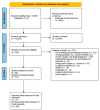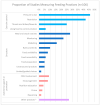Parental Feeding Practices in Families Experiencing Food Insecurity: A Scoping Review
- PMID: 35564998
- PMCID: PMC9099728
- DOI: 10.3390/ijerph19095604
Parental Feeding Practices in Families Experiencing Food Insecurity: A Scoping Review
Abstract
Parental feeding practices and styles influence child diet quality and growth. The extent to which these factors have been assessed in the context of disadvantage, particularly household food insecurity (HFI), is unknown. This is important, as interventions designed to increase responsive practices and styles may not consider the unique needs of families with HFI. To address this gap, a scoping review of studies published from 1990 to July 2021 in three electronic databases was conducted. A priori inclusion criteria were, population: families with children aged 0-5 years experiencing food insecurity and/or disadvantage; concept: parental feeding practices/behaviours/style; and context: high income countries. The search identified 12,950 unique papers, 504 full-text articles were screened and 131 met the inclusion criteria. Almost all the studies (91%) were conducted in the United States with recruitment via existing programs for families on low incomes. Only 27 papers assessed feeding practices or styles in the context of HFI. Of the eleven interventions identified, two assessed the proportion of participants who were food insecure. More research is required in families outside of the United States, with an emphasis on comprehensive and valid measures of HFI and feeding practices. Intervention design should be sensitive to factors associated with poverty, including food insecurity.
Keywords: feeding practices; food insecurity; infant feeding; parents; responsive feeding; scoping review.
Conflict of interest statement
The WCCNR is funded by Woolworths through the Children’s Hospital Foundation. Woolworths has not been involved in the design or conduct of the research or in the evaluation of the scientific quality of the research projects or in the establishment of the Centre governance.
Figures
Similar articles
-
Feeding Practices Used by Australian Parents of Young Children Living With Food Insecurity and Household Chaos.Matern Child Nutr. 2025 Apr;21(2):e13770. doi: 10.1111/mcn.13770. Epub 2024 Nov 25. Matern Child Nutr. 2025. PMID: 39584781 Free PMC article.
-
Head Start Parents With or Without Food Insecurity and With Lower Food Resource Management Skills Use Less Positive Feeding Practices in Preschool-Age Children.J Nutr. 2021 May 11;151(5):1294-1301. doi: 10.1093/jn/nxab001. J Nutr. 2021. PMID: 33693811 Free PMC article.
-
Food insecurity and obesogenic maternal infant feeding styles and practices in low-income families.Pediatrics. 2012 Aug;130(2):254-61. doi: 10.1542/peds.2011-3588. Epub 2012 Jul 23. Pediatrics. 2012. PMID: 22826569
-
The Relation Between Household Food Insecurity and Children's Height in Canada and the United States: A Scoping Review.Adv Nutr. 2019 Nov 1;10(6):1126-1137. doi: 10.1093/advances/nmz034. Adv Nutr. 2019. PMID: 31075160 Free PMC article.
-
Factors Associated with Food Insecurity among Pregnant Women and Caregivers of Children Aged 0-6 Years: A Scoping Review.Nutrients. 2022 Jun 9;14(12):2407. doi: 10.3390/nu14122407. Nutrients. 2022. PMID: 35745136 Free PMC article.
Cited by
-
A Scoping Review of Household Factors Contributing to Dietary Quality and Food Security in Low-Income Households with School-Age Children in the United States.Adv Nutr. 2023 Jul;14(4):914-945. doi: 10.1016/j.advnut.2023.05.006. Epub 2023 May 13. Adv Nutr. 2023. PMID: 37182740 Free PMC article.
-
The sDOR.2-6y™ Is a Valid Measure of Nutrition Risk Independent of BMI-for-Age z-Score and Household Food Security Status in Preschool Aged-Children.Nutrients. 2024 Mar 7;16(6):767. doi: 10.3390/nu16060767. Nutrients. 2024. PMID: 38542679 Free PMC article.
-
Feeding Practices Used by Australian Parents of Young Children Living With Food Insecurity and Household Chaos.Matern Child Nutr. 2025 Apr;21(2):e13770. doi: 10.1111/mcn.13770. Epub 2024 Nov 25. Matern Child Nutr. 2025. PMID: 39584781 Free PMC article.
-
Measuring Food Insecurity in Children under 5 Years of Age with Acute Undernutrition in Valle Del Cauca-Colombia.Children (Basel). 2024 Sep 24;11(10):1155. doi: 10.3390/children11101155. Children (Basel). 2024. PMID: 39457119 Free PMC article.
-
Food parenting stress among caregivers receiving government food assistance: a study from the United States.Prev Med Rep. 2025 Jul 27;57:103189. doi: 10.1016/j.pmedr.2025.103189. eCollection 2025 Sep. Prev Med Rep. 2025. PMID: 40791293 Free PMC article.
References
-
- Vaughn A.E., Ward D.S., Fisher J.O., Faith M.S., Hughes S.O., Kremers S.P., Musher-Eizenman D.R., O’Connor T.M., Patrick H., Power T.G. Fundamental constructs in food parenting practices: A content map to guide future research. Nutr. Rev. 2016;74:98–117. doi: 10.1093/nutrit/nuv061. - DOI - PMC - PubMed
Publication types
MeSH terms
LinkOut - more resources
Full Text Sources
Medical
Miscellaneous



